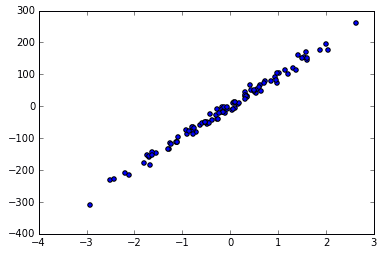$ ls ~yifei/notes/
sklearn 入门笔记
Posted on:
Last modified:
前一阵看了一个叫做 [莫烦 Python][1] 的教程,还有 [sklearn 的官方教程][2] 初步了解了一下 sklearn 的基本概念,不过教程毕竟有些啰嗦,还是自己记录一下关键要点备忘。
什么是机器学习?
Sklearn 给了一个定义:
In general, a learning problem considers a set of n samples of data and then tries to predict properties of unknown data.
If each sample is more than a single number and, for instance, a multi-dimensional entry (aka multivariate data), it is said to have several attributes or features.
翻译过来:
总的来说,“学习问题”通过研究一组 n 个样本的数据来预测未知数据的属性。比如说,如果每个样本 都不止包含一个数字,而是多维的向量,那么就称它为有多个 feature。
要解决的问题
- Classification 分类,也就是离散的目标值
- Regression 回归,也就是连续的目标值
- Clustering 聚类,无监督的学习
- Dimensionality reduction 数据降维,进一步处理数据
要实现上面几个目标,可能需要下面的步骤:
- Model Selection 模型选择
- Preprocessing 数据预处理
要去判定自己的任务需要用哪种方法,优先参考 sklearn 官方推出的:
自带的数据库
Sklearn 为了方便学习自带了一些数据库,可以说是非常方便了。包括了 iris 花瓣数据库,手写 数字数据库等。这些例子相当于编程语言的 hello world 或者是图形学届的 Utah teapot 了。
除了真实的数据集,还可以使用datasets.make_*系列函数来直接生成一些数据集用来测试。
>>> from sklearn import datasets
>>> iris = datasets.load_iris() # iris 花瓣数据库
>>> digits = datasets.load_digits() # 手写数字数据库
>>> print(digits.data) # 数据库的输入
[[ 0. 0. 5. ..., 0. 0. 0.]
[ 0. 0. 0. ..., 10. 0. 0.]
[ 0. 0. 0. ..., 16. 9. 0.]
...,
[ 0. 0. 1. ..., 6. 0. 0.]
[ 0. 0. 2. ..., 12. 0. 0.]
[ 0. 0. 10. ..., 12. 1. 0.]]
>>> digits.target # 数据库的输出
array([0, 1, 2, ..., 8, 9, 8])其中 data 属性是一个二维数组,格式是(n_samples, n_features).
训练模型
首先使用 sklearn 自带的 train_test_split 函数来分割训练和测试数据
from sklearn.model_selection import train_test_split
X_train, X_test, y_train, y_test = train_test_split(iris_X, iris_y, test_size=0.3)- fit 利用训练集计算模型的参数,transform 利用 fit 计算出来的参数处理数据。
- 使用 fit_transform 训练数据,使用 transform 处理测试集。测试集不需要 fit,应该使用训练集 的参数
fit_transform == fit().transform()但是 fit_transform 可能更高效
使用模型
我们使用 model.predict 来给出预测
# 对于分类模型
model.predict(y) # 给出 y 的分类
model.predict_proba(y) # 给出 y 在每一类的概率保存模型
模型一般都是离线训练之后,保存模型,然后在线调用。可以直接使用 Python 内置的 pickle 模块, 但是一般模型数据都比较大,pickle 对大文件支持不好,最好采用 sklearn 自带的 joblib.
>>> from sklearn.externals import joblib
>>> joblib.dump(classifier, "filename.model")
>>> classifier = joblib.load("filename.model")其他的一些技巧
一些约定
上面说到 sklearn 约定了 fit 和 predict 方法,还有一些其他的约定
- 所有的输入都会被转化为 float64 类型
- 一半习惯用
X表示样本数据,y表示预测结果
可视化
>>> X, y = datasets.make_regression(n_samples=100, n_features=1, n_targets=1, noise=10)
>>> plt.scatter(X, y)
>>> plt.show()会有下面的图

参考
- https://sklearn.apachecn.org/docs/0.21.3/2.html
- https://morvanzhou.github.io/tutorials/machine-learning/sklearn/1-1-why/
- http://scikit-learn.org/stable/tutorial/basic/tutorial.html
- http://scikit-learn.org/stable/modules/generated/sklearn.model_selection.train_test_split.html
- https://mp.weixin.qq.com/s/Z5lD-6Ha2PdeLSrPyNc92w
- https://mp.weixin.qq.com/s/PjtIJp5di7M0eNeXhjjlJw
- https://mp.weixin.qq.com/s/Nh_YWBMmHNOe5Qddsp8HQg
- https://mp.weixin.qq.com/s/qKsXpegnnTsF3noUx0ia_g
- https://stackoverflow.com/questions/48692500/fit-transform-on-training-data-and-transform-on-test-data
- https://stackoverflow.com/questions/23838056/what-is-the-difference-between-transform-and-fit-transform-in-sklearn
- https://stackoverflow.com/questions/61184906/difference-between-predict-vs-predict-proba-in-scikit-learn
- https://mp.weixin.qq.com/s?__biz=MzIzNTg3MDQyMQ==&mid=2247484994&idx=1&sn=98e3fcd9f9e03570b93c48075fd6dc6f
- https://mp.weixin.qq.com/s/Z5lD-6Ha2PdeLSrPyNc92w
- https://scikit-learn.org/stable/getting_started.html
© 2016-2022 Yifei Kong. Powered by ynotes
All contents are under the CC-BY-NC-SA license, if not otherwise specified.
Opinions expressed here are solely my own and do not express the views or opinions of my employer.
友情链接: MySQL 教程站